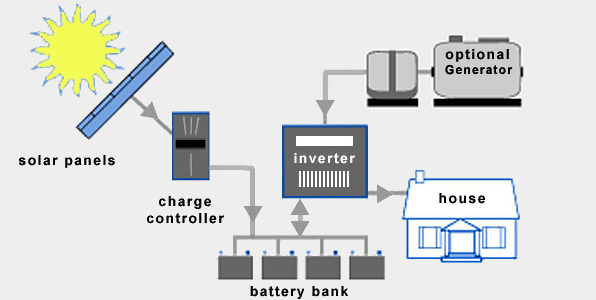Off-Grid Solar Systems
An off-grid solar system (standalone) is the obvious alternative to one that is Grid tied. For Homeowners that have access to the grid, off grid solar systems are usually out of question. Here is why...
To ensure access to electricity at all times, off-grid solar systems require battery storage and a backup generator (if you live off-the-grid). On top of this, a battery bank typically needs to be replaced after 10 years. Batteries are complicated, expensive and decrease overall system efficiency.

Advantages of Off-Grid Solar Systems
1. No access to the utility grid
Off-grid solar systems can be cheaper than extending power lines in certain remote areas.
Consider off-gird if you’re more than 100 yards from the grid. The costs of overhead transmission lines range from $174,000 per mile (for rural construction) to $11,000,000 per mile
2. Become Energy self sufficient
Living off the grid and being self-sufficient feels good. For some people, this feeling is worth more than saving money. Energy self-sufficiency is also a form of security. Power failures on the utility grid do not affect off-grid solar systems.
On the flip side, batteries can only store a certain amount of energy, and during cloudy times, being connected to the grid is actually where the security is. You should install a backup generator to be prepared for these kinds of situations.
Equipment for Off Grid Solar Systems
Typical off-grid solar systems require the following extra components:
- Solar panel set
- Solar Charge Controller
- Battery Bank
- DC Disconnect (Additional)
- Off-Grid Inverter
Solar Charging Controller
Solar charge controllers are also known as charge regulators or just battery regulators. The last term is probably the best to describe what this device actually does: Solar battery chargers limit the rate of current being delivered to the battery bank and protect the batteries from overcharging.
Good charge controllers are crucial for keeping the batteries healthy, which ensures the lifetime of a battery bank is maximized. If you have a battery-based inverter, chances are that the charge controller is integrated.
Battery Bank
Without a battery bank (or a Generator) it’ll be lights out by sunset. A battery bank is essentially a group of batteries wired together.
DC Disconnect Switch
AC and DC safety disconnects are required for all solar systems. For off-grid solar systems, one additional DC disconnect is installed between the battery bank and the off-grid inverter. It is used to switch off the current flowing between these components. This is important for maintenance, troubleshooting & protection against electrical fires.
Off-Grid Inverter
There’s no need for an inverter if you`re only setting up solar panels for your boat, your RV, or something else that runs on DC current. You will need an inverter to convert DC to AC for all other electrical appliances.
Off Grid inverters do not have to match phase with the utility sine wave as opposed to grid-tie inverters. Electrical current flows from the solar panels through the solar charge controller and the bank battery bank before it is finally converted into AC by the off-grid-inverter